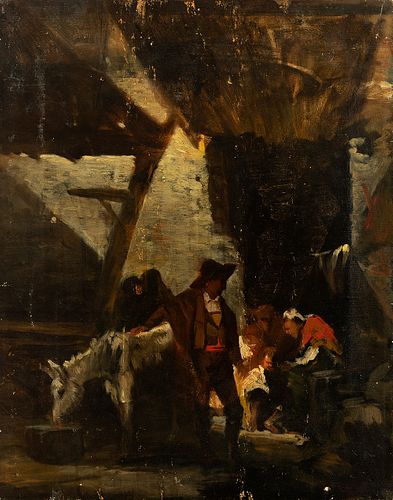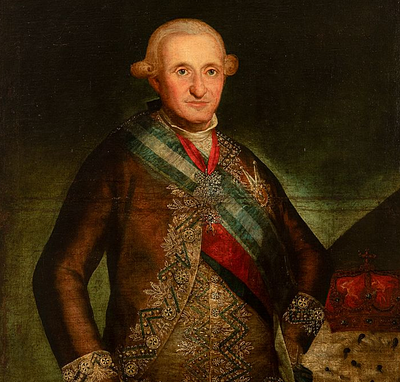Spanish school; late 19th century. "Costumbrist scene". Oil on canvas.
Lot 59
About Seller
Setdart Auction House
Carrer Aragó 346
Barcelona
Spain
Setdart Subastas was born in 2004 and is currently the first online art auction in Spain with solidity, prestige and reliability guaranteed by our more than 60,000 users. Setdart has a young, dynamic and enterprising team ready to successfully manage the purchase and sale of art works through custom...Read more
Estimate:
EUR€2,000 - EUR€2,500
$2,061.86 - $2,577.32
Absentee vs Live bid
Two ways to bid:
- Leave a max absentee bid and the platform will bid on your behalf up to your maximum bid during the live auction.
- Bid live during the auction and your bids will be submitted real-time to the auctioneer.
Bid Increments
| Price | Bid Increment |
|---|---|
| EUR€0 | EUR€10 |
| EUR€200 | EUR€25 |
| EUR€500 | EUR€50 |
| EUR€1,000 | EUR€100 |
| EUR€3,000 | EUR€200 |
| EUR€5,000 | EUR€500 |
| EUR€10,000 | EUR€1,000 |
| EUR€20,000 | EUR€2,000 |
| EUR€50,000 | EUR€5,000 |
About Auction
By Setdart Auction House
Sep 22, 2021
Set Reminder
2021-09-22 09:30:00
2021-09-22 09:30:00
America/New_York
Bidsquare
Bidsquare : 22nd September - ARAS JÁUREGUI Private Collection - Old Masters, 19th & 20th Century
https://www.bidsquare.com/auctions/setdart-auction-house/22nd-september---aras-j-uregui-private-collection---old-masters-19th-20th-century-7427
ARAS JÁUREGUI Private Collection - Old Masters, 19th & 20th Century Setdart Auction House sofia@setdart.com
ARAS JÁUREGUI Private Collection - Old Masters, 19th & 20th Century Setdart Auction House sofia@setdart.com
- Lot Description
Spanish school; late 19th century. "Costumbrist scene". Oil on canvas. The original canvas is preserved. Measurements: 40,5 x 23,5 cm. Work whose theme is developed in an interior, that for the characteristics it looks like an inn, or a stable. In the foreground, a blurred figure is placed next to a donkey, while in the background three characters complete the scene. This work was formerly attributed to Eduardo Rosales. Born into a humble family, Rosales trained in the Nazarenism that dominated the Madrid Academy of Fine Arts at the time, where he entered in 1851 and was a pupil of Federico de Madrazo. Thanks to friends and colleagues, including the painters Palmaroli and Álvarez Catalá, Rosales travelled to Italy by his own means in 1857 in their company. Traditionally, Spanish painting and literature have been interested in popular customs and types. The arrival of Romanticism enlivened this trend, bringing to the Hispanic tradition the vision that foreigners had of our people, due to the snobbery of a Europeanising and liberal national bourgeoisie which, also due to foreign influence and under the Romantic fashion, turned its eyes to the people and monuments of the past. This, which was general throughout Spain, was particularly prevalent in Andalusia, as this land was the dream destination of foreigners, and where the influence of the vision they had of the Spaniards and their peculiar customs had to be felt most strongly. Thus, of the two fundamental costumbrista schools, the Sevillian school of painting is focused on a gentle, folkloric picturesqueness, far removed from any attempt at social criticism; the Madrid school, on the other hand, is more pungent and harsh, sometimes going so far as to depict not only the vulgar, but even recreating heartbreaking visions of a clichéd world, in which the spirit of criticism is evident. The Cadiz precursors Juan Rodríguez y Jiménez and Joaquín Manuel Fernández Cruzado were followed by a splendid development of the Seville school, in which foreign influence seems to have played an important role owing to the influx of artists and travellers to the city and the interest of foreign clients in the clichéd Spanish costumbrista scenes.
- Shipping Info
-
In-house shipping available. Please inquire at admin@setdart.com.
-
- Buyer's Premium



 EUR
EUR CAD
CAD AUD
AUD GBP
GBP MXN
MXN HKD
HKD CNY
CNY MYR
MYR SEK
SEK SGD
SGD CHF
CHF THB
THB














